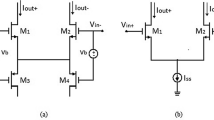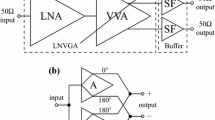Abstract
In this paper a variable gain low noise amplifier (VG-LNA) is designed and analyzed for X band in 0.18 µm CMOS technology. A two-stage structure is utilized in the proposed VG-LNA and its gain, which is controlled by an on-chip voltage (Vcnt), has continuous and almost linear variations. The required range for Vcnt can be initiated from 0.5 V, also the variations of gain doesn’t ruin reflection loss (S11), return loss (S12) and noise figure (NF). The best performance of this VG-LNA is at 10 GHz frequency with 1 GHz bandwidth. In the center frequency, the maximum gain is 20.8 dB that continuously and linearly decreases to 4 dB by increasing Vcnt. Also S11 and S12 in this frequency are lower than −27 and −38 dB, respectively. NF is lower than 2 dB in the mentioned frequency range and NFmin is equal to 1.2 dB, while the third-order intercept point (IIP3) equals to 8.27 dBm in the best condition and always stays above −10 dBm. The main advantage of the proposed structure in compare with the similar structures is not only the key parameters don’t ruin by the gain variations, but also increment of Vcnt operation range (0.5 V to Vdd), leads to expanding gain control range. These results are achieved while the power consumption is 8.4 mW with 1.8 V supply voltage and the chip area is 0.56 mm2.















Similar content being viewed by others
References
Razavi, B. (2011). RF microelectronics (2nd ed.). Upper Saddle River: Prentice Hall.
Jeong, C. J., Sun, Y., Han, S. K., & Lee, S. G. (2015). A 2.2 mW, 40 dB automatic gain controllable low noise amplifier for FM receiver. IEEE Transactions on Circuits and Systems I: Regular Papers, 62(2), 600–606.
Wei, M. D., Chang, S. F., & Negra, R. (2010). A DC-invariant gain control technique for CMOS differential variable-gain low-noise amplifiers. In NORCHIP, IEEE (pp. 1–4).
Zhao, Y., Wu, W., Wen, W., Li, W., & Hou, X. (2015). A 0.5-mA ultra-low-power low noise amplifier in 0.13 μm CMOS. In 2015 IEEE advanced information technology, electronic and automation control conference (IAEAC), IEEE (pp. 31–34).
Nguyen, T. K., Kim, C. H., Ihm, G. J., Yang, M. S., & Lee, S. G. (2004). CMOS low-noise amplifier design optimization techniques. IEEE Transactions on Microwave Theory and Techniques, 52(5), 1433–1442.
Jin, T. H., & Kim, T. W. (2010). A 5.5-mW 9.4-dBm IIP3 1.8-dB NF CMOS LNA employing multiple gated transistors with capacitance desensitization. IEEE Transactions on Microwave Theory and Techniques, 58(10), 2529–2537.
Huang, B. J., Lin, K. Y., & Wang, H. (2009). Millimeter-wave low power and miniature CMOS multicascode low-noise amplifiers with noise reduction topology. IEEE Transactions on Microwave Theory and Techniques, 57(12), 3049–3059.
Kia, H. B. (2014). Adaptive CMOS LNA using highly tunable active inductor. In 2014 22nd Iranian conference on electrical engineering (ICEE), IEEE (pp. 1–6).
Wang, S. F., Hwang, Y. S., Yan, S. C., & Chen, J. J. (2011). A new CMOS wideband low noise amplifier with gain control. Integration, the VLSI Journal, 44(2), 136–143.
Hwang, Y. S., Wang, S. F., Yan, S. C., & Chen, J. J. (2010). An inductorless wideband noise-cancelling CMOS low noise amplifier with variable-gain technique for DTV tuner application. AEU-International Journal of Electronics and Communications, 64(11), 1009–1014.
Sung, G. M., & Zhang, X. J. (2013). A 2.4-GHz/5.25-GHz CMOS variable gain low noise amplifier using gate voltage adjustment. In 2013 IEEE 56th international midwest symposium on circuits and systems (MWSCAS), IEEE (pp. 776–779).
Sun, K. J., Tsai, Z. M., Lin, K. Y., & Wang, H. (2006). A noise optimization formulation for CMOS low-noise amplifiers with on-chip low-Q inductors. IEEE Transactions on Microwave Theory and Techniques, 54(4), 1554–1560.
Nouri, M., & Karimi, G. (2014). A novel 2.5–3.1 GHz wide-band low-noise amplifier in 0.18 μm CMOS. Wireless Personal Communications, 79(3), 1993–2003.
Author information
Authors and Affiliations
Corresponding author
Rights and permissions
About this article
Cite this article
Nikbakhsh, M.R., Abiri, E., Ghasemian, H. et al. A Two Stage Variable-Gain Low-Noise Amplifier for X-Band in 0.18 µm CMOS. Wireless Pers Commun 98, 173–187 (2018). https://doi.org/10.1007/s11277-017-4862-3
Published:
Issue Date:
DOI: https://doi.org/10.1007/s11277-017-4862-3




